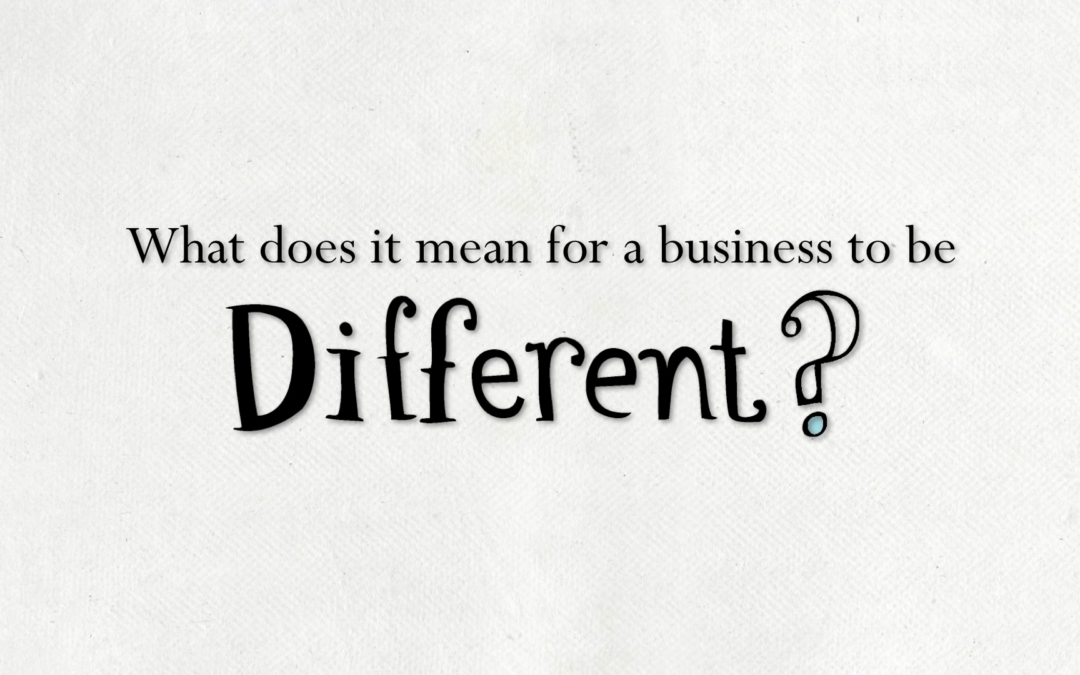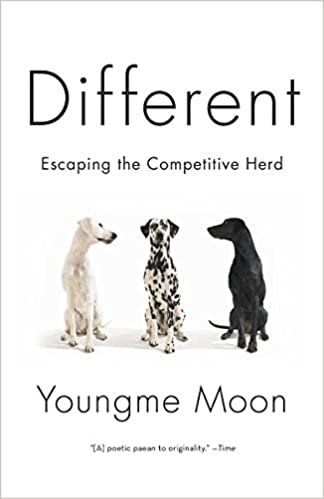In a recent conversation with a CEO from a technology company, she asked me my favorite marketing book from the last ten years. I didn’t hesitate. The answer was Different by Youngeme Moon. The book was published September 6, 2011, and is as relevant today as a decade ago. I reread it once a year. This book helps me avoid the great blur of sameness in my marketing practice.
Some business and marketing books have little or nothing new to say. They don’t make me think – they regurgitate old ideas. Many marketing and general business books repeat the same mantras with an emphasis on a small insight or take a nuanced idea and shine a very bright light upon it.
Plenty of marketing books typically have one big idea illustrated over 100 pages and probably should have been a blog post. Of course, there are exceptions – but why say something in 50,000 words when you can say it in 1,000?
Some of my favorite marketing/business authors like Adam Grant, Seth Godin, Martin Lindstrom, Mark Schaefer, Felix Oberholtzer-Gee, Robert Cialdini, and Chip & Dan Heath, like Youngme Moon, are exceptions to my caveat. Their books are filled with wisdom and masterclasses in marketing. a
When a book is superbly written with a clever and provocative way of viewing the world, I know I can learn something and enjoy the journey too. Books that keep reminding me to think differently, inspire me to challenge everything.
But, of all that I have read, my favorite marketing book from the last decade is Different since I come back to reread it every year. It is like hitting the marketing refresh button.
The Great Blur Toward Sameness
Different is written by Harvard’s marketing and business school professor Youngme Moon. Her book, aptly named, is an enlightening look at marketing.
She argues how in a struggle to be different brands are merging, and categories are taking prominence. When every battle is to add a feature, the competitive landscape becomes more similar than different.
Think about the toothpaste aisle, and when one brand adds tartar control, the others respond. When mouthwash is added, the herd follows. Marketers engage in augmenting, counting, and slipping toward sameness. Youngme describes this as a great blur toward sameness.
She identifies three types of marketing strategies that are different and lead to a fresh approach. And, in an exciting method for promoting this book, she created a trailer- as you would find in movies- to help describe her thesis. Nothing like illustrating your thesis on being different by being different! You can watch it here. Remember, this trailer is ten years old and now, video to promote books is more fashionable.
What I appreciate and value about Different is that Moon’s writing style and approach to the subject get into the contours and folds of marketing in interesting ways. She tells stories not as an academic but as a Mom and a consumer and brings a fresh framework of understanding.
Serial Marketing
In one chapter, standing in the cereal aisle, she describes how people categorize the cereal brands, and honestly, nothing stands out because everyone is playing by category rules. Everything merges into a breakfast blend of brands. No one is challenging the approach to what cereal means since it is always about adding and augmenting with more fiber, less sugar, less fat, more this, and less than.
Those who buy cereal know the rules of categorization for this aisle, can segment kids versus adult brands or indulgent versus low-fat. But nothing is different.
Three Brand Archetypes For Being Truly Different
Reverse brands will eliminate benefits and featuring new dimensions in the category. In removing features, they add new value and bring forward areas to emphasize that are often missed. Ikea illustrates this point because, unlike most furniture stores, they do not provide the essential features of assembly, delivery, or sales help. Category mandatory requirements aren’t provided. Instead, they offer a fresh approach to buying furniture. The strength of their brand is in what they don’t provide and in reframing the way the entire category operates. Ikea avoids the great blur of sameness by being different in a meaningful way.
Breakaway brands push the category into a new direction or place and redefine the space. She talks about Swatch and how they redefined the category of watches in fresh and unexpected ways as precision and telling the time to take a back seat to fashion and accessories. Swatch redefined what it meant to sell a timepiece and put the emphasis on style over function.
Hostile brands try to keep people out by making membership in the brand hard work. They tend to be highly polarizing forces that require you to get off the fence and make a choice- love it or hate it. Brands like Red Bull or Benetton are examples of brands that push your buttons and establish difficult entry points for becoming a member of their tribe. She describes a great model = Marmite, and a portion of food spread made from beer yeast by-products, whose tagline is “Love it or hate it.” When was the last time your brand forced your target to commit?
Pulling Your Brand Up
Products like Pull-Ups are an intriguing example of how the diaper companies were struggling to find ways to keep children who grew out of traditional diapers (Pampers from P&G and Huggies by Kimberly Clark) in the category of needing something to protect their clothes.
Their consumers stay in the category a short time- 2-3 years, so the challenge was how to get them to stay longer. 3-year-old kids don’t want to wear diapers anymore because they see themselves as big boys and girls. In rethinking what a diaper is, Kimberly Clark re-imagined the product and made children’s underwear with diaper-like protection called Pull-Ups. This created a new sub-category of big kid underpants. Today it’s the fastest-growing segment of that overall category, and it did it by rethinking the definition of a diaper.
Food, Fans and Fascination
I am always interested in new ways of seeing old things. In my food world, I recently found a recipe for lasagna cupcakes. It’s a great example of rethinking what lasagna could mean when you change the shape and form it delivers.
Dyson’s introduction of a fan without a blade is another beautiful example of challenging the essence of a brand by deleting one of the features (a blade) that you assume has to be part of the product.
If, like me, you are fascinated by marketing and enjoy allowing your brain to be stretched into new places, Different is a must-read book about the discipline of marketing. The book is never pedantic or preachy. The book gently walks with you through the maze of marketing sameness and shines a light on different means.
Be different. Read something fresh that challenges your worldview. Avoid the great blur of sameness in marketing.
P.S. if you want to hear great discussions on marketing and sales books every week, subscribe to The Marketing Book Podcast Hosted by Douglas Burdett. He reads each book and interviews the authors. For those with limited time to spend reading, this is a great way to keep up with the world of marketing.
Images: All rights reserved by Youngme Moon and Dyson






